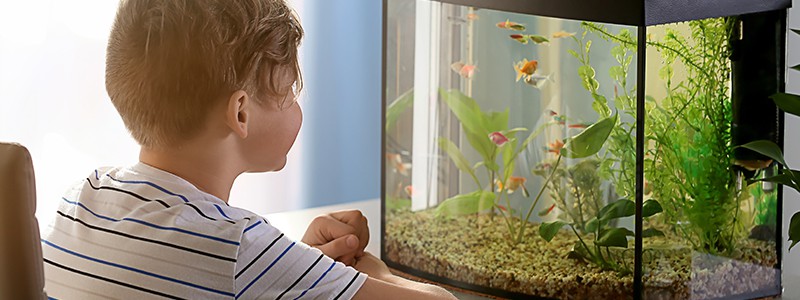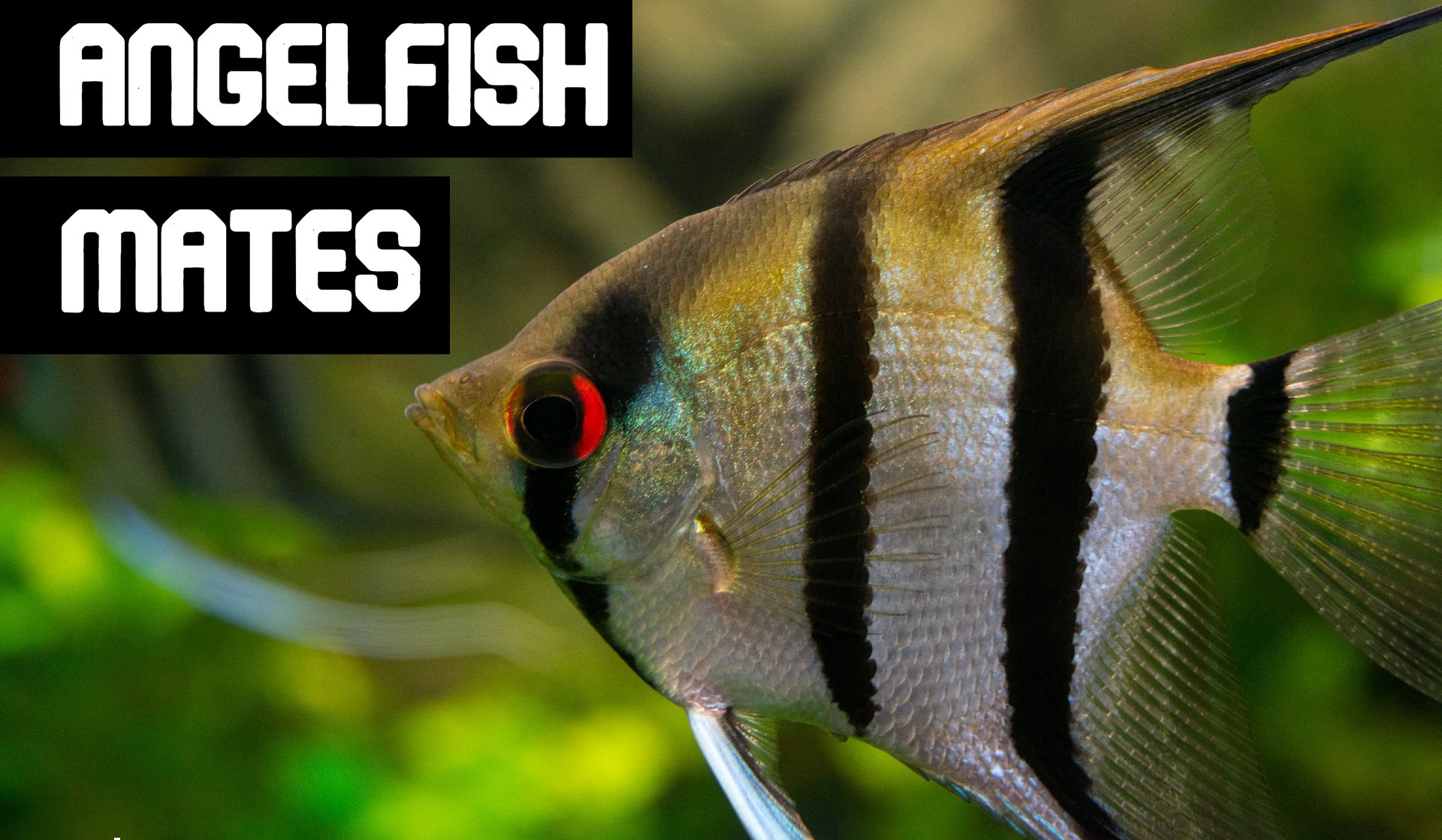We all know that fish tanks are soothing and peaceful for adults—or at least, we feel better after staring at our fish for a while—but what about kids? Do fish tanks offer children any benefits besides getting to watch the beautiful, interesting fish inside? Yes, they do:
- Increased knowledge
- Abstract thinking skills
- Responsibility and discipline
You may remember having a class aquarium in school, or some other type of class pet. Or maybe you grew up with fish at home—even if it was just a goldfish you won at the local fair that quickly died after you brought it home!
Were you learning anything from that experience? You bet! Let’s explore several benefits of aquariums for kids in this article.
Aquarium Benefits at Home
Let’s start with all the parents, grandparents, aunts, and uncles out there who are thinking about setting up an aquarium at home, but just aren’t sure if the kids in your life will learn anything from it, or even be interested in a tank.
To be honest, today’s kids spend less time around nature, and far more time staring at screens than any prior generation.
Aquariums give children the chance to experience a little bit of nature right in their own home!
Increased Knowledge
Involve children in the process of setting up your tank, and watch in amazement as the questions flow like the water you’re pouring into the aquarium:
- Why do fish need decorations?
- What’s the filter for?
- Why does the tank need a heater?
- How come the water needs to be treated first?
- What does the gravel do?
You’ll be amazed at how much kids can learn just by helping you get the tank ready—before you even have any fish! Let them pour in some gravel, add a decoration or two, help you attach the filter, or stick on the thermometer.
The more they get to do, the better. Kids will have more ownership and interest in a tank they’ve helped you set up.
And, as they work with you to get it ready, you can answer all those questions bubbling up—without even noticing that you’re teaching them about underwater habitats, fish behavior, underwater ecosystems, chemistry, and the nitrogen cycle!
You’re an expert in a lot of different areas you probably never realized! And kids will eat up the information you give them when they get to be part of the process. So, let them add that decoration to the tank, even if it is just a little bit crooked.
Even toddlers can get in on the action by counting the fish in the tank and practicing their number skills, naming the colors of the fish in the tank, reciting the names of the fish, or even naming all of the objects they see in the tank. Make a game of it! Before you know it, they’ll be dragging you over to the tank to show off their knowledge.

Abstract Thinking Skills
To most people, the fun really begins with choosing which fish to add to your tank. Believe it or not, this is where a lot of learning takes place, too!
If you can, involve kids in this process, too, by bringing them along to the fish store with you when you select your fish, or by reviewing potential tank mates online.
You can create learning opportunities by:
- Discuss the pros and cons of each fish you’re considering—and let your child helper give their input, too!
- Throwing in a little math on the sly—how many 2-inch fish can you get if you need two gallons of water per inch of fish? Is your fish tank too small, too big, or just right?
- Discussing the fish roles, you need to fill in your tank—algae eaters, cleaner fish, main fish, etc.
Again, it might not seem like you’re teaching anything—but through these conversations, kids are learning to think logically. “Which fish is the best option for the size of the tank, the type of community being created, and the roles that need to be filled?”
They learn how to select fish for a community tank instead of just picking out a fish because “It’s pretty!”
You’re also working on consequences: “If I choose incompatible tank mates, they could hurt each other.” Or, “If we don’t have enough cleaner fish, waste will build up in the tank.”
By sharing the various roles different fish species play, and the unique characteristics that make each species special, you’re also teaching them to have respect for nature. The whole process helps kids realize that aquarium fish are unique animals with their own social structures, preferences, and needs, not just decorations.
Responsibility and Discipline
If the kids in your life are old enough, they can help you with daily feedings, monthly water changes, filter media replacement, and even testing water parameters. (You’ll want to help them understand what the results mean, though!)
Taking care of something that depends on them teaches kids responsibility. It helps them realize that what they do is important and that sometimes things need to get done (like feeding the fish) even when they don’t feel like doing it (because there’s a cool video game they’d rather be playing).
And, doing daily feedings helps with discipline, too—it’s a small task that needs to be done daily, no matter what else is going on. That also involves time management, by making sure other tasks are done in time to feed the fish on their normal schedule.
These are lifelong lessons kids will need when the stakes get higher—at work or school and in relationships.
Cognitive, Emotional, and Behavioral Benefits
The benefits of keeping a fish tank go well beyond the information and skills you can teach a child—aquariums also have a direct effect on the mental, emotional, and behavioral well-being of both children and adults. If you feel more relaxed after watching your fish for a while, it’s not just your imagination!
Studies have shown that being in the presence of a fish tank lowers blood pressure and reduces stress, and who couldn’t use that?
But that’s not all—other studies looked at anxiety and found that being around aquariums did in fact reduce anxiety in the study participants.
Interestingly, studies have also shown that watching fish in an aquarium helps calm kids with hyperactivity disorders. Observing fish is a very soothing activity.
Another study looked at whether caring for fish had any health benefits for kids with type I diabetes and found that those who fed their fish and did water changes did a better job of managing their blood sugar.
Because most of these benefits are associated with just spending time around aquariums and passively watching the fish, any child regardless of their physical or developmental limitations can enjoy the benefits of a fish tank!

Fish Tank Benefits at School
Of course, all those great lessons your kids are learning from keeping a tank at home will help them out in school, too! But if you’re a teacher, there are lots of things you can do with a tank in your classroom.
Research Skills
You can have students do research projects on the fish species in your tank:
- Where do they live in the wild?
- Are they a community fish?
- Are they aggressive?
- What do they typically eat?
- Are they an endangered species?
And you can probably come up with many more questions for your students to consider!
You could also have them draw the fish in their natural habitat as part of the research project, create a PowerPoint, or other audio-visual presentation to share with the class, or simply have them write a report to present orally.
Science and Math
There are almost limitless possibilities here! You could easily create word problems around the size of the tank and the number of fish to be added or removed to achieve a specific result.
You could also teach lessons on fish anatomy, the differences between scaled and scale-less fish, or dive into chemistry and the scientific method by charting out the chemical composition of the water using test kits and then marking any spikes or differences over time. Then, your students can create hypotheses for why those changes occurred and test their theories.
And that’s not all, of course! There are great lessons about the water cycle and the nitrogen cycle, too, along with how ecosystems function and conservation. Really, a fish tank opens up a whole world of teaching topics.
In Summary
Not only are aquariums a fun and peaceful hobby, they also bring a lot of educational benefits to the kids who spend time around them! A few of those benefits include:
- Math and number skills
- Learning responsibility and self-discipline
- Understanding consequences
- Logical thinking—choosing what is best for the tank, not just what I like
- Understanding scientific concepts like water parameters, the nitrogen cycle, and species roles in the tank
So, go ahead and pick up a fish tank today and start kids on a lifelong adventure of discovery and learning!




